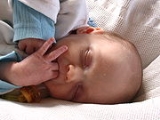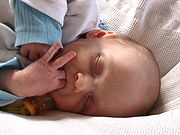
Thumb sucking
Encyclopedia

Ring-tailed Lemur
The ring-tailed lemur is a large strepsirrhine primate and the most recognized lemur due to its long, black and white ringed tail. It belongs to Lemuridae, one of five lemur families. It is the only member of the Lemur genus. Like all lemurs it is endemic to the island of Madagascar...
s, and other primates. It usually involves placing the thumb
Thumb
The thumb is the first digit of the hand. When a person is standing in the medical anatomical position , the thumb is the lateral-most digit...
into the mouth and rhythmically repeating sucking contact for a prolonged duration. It can also be accomplished with any piece of skin within reach (such as the big toe) and is considered to be soothing and therapeutic for the person.
At birth, a baby will reflex
Reflex
A reflex action, also known as a reflex, is an involuntary and nearly instantaneous movement in response to a stimulus. A true reflex is a behavior which is mediated via the reflex arc; this does not apply to casual uses of the term 'reflex'.-See also:...
ively suck any object placed in its mouth; this is the sucking reflex responsible for breastfeeding
Breastfeeding
Breastfeeding is the feeding of an infant or young child with breast milk directly from female human breasts rather than from a baby bottle or other container. Babies have a sucking reflex that enables them to suck and swallow milk. It is recommended that mothers breastfeed for six months or...
. This reflex disappears at about 4 months of age; thumb sucking is not purely an instinctive behavior and therefore can last much longer. Moreover, ultrasound
Ultrasound
Ultrasound is cyclic sound pressure with a frequency greater than the upper limit of human hearing. Ultrasound is thus not separated from "normal" sound based on differences in physical properties, only the fact that humans cannot hear it. Although this limit varies from person to person, it is...
scans have revealed that thumb sucking can start before birth, as early as 15 weeks from conception; whether this behavior is voluntary or due to random movements of the fetus in the womb is not conclusively known.
Children suck on objects (including pacifiers) to soothe themselves; sucking is one of a baby's natural reflexes and completely typical for babies and young children. As a child develops the habit, it will usually develop a "favorite" finger to suck on.
Thumb sucking can start as early as 15 weeks of growth in the uterus
Uterus
The uterus or womb is a major female hormone-responsive reproductive sex organ of most mammals including humans. One end, the cervix, opens into the vagina, while the other is connected to one or both fallopian tubes, depending on the species...
or within months of being born. Prior to 12 weeks, the fetus has webbed digits. Most thumb-suckers stop gradually by the time they are 5 years old. Nevertheless, some older children will retain the habit, some into adulthood. Thumb sucking in adults may be due to stereotypic movement disorder
Stereotypic movement disorder
Stereotypic movement disorder is a disorder of childhood involving repetitive, nonfunctional motor behavior , that markedly interferes with normal activities or results in bodily injury, and persists for four weeks or longer. The behavior must not be due to the direct effects of a substance or...
, another psychiatric disorder, or simply habit continuation.
Dental problems

Most children stop sucking on thumbs, pacifiers or other objects on their own between 2 and 4 years of age. No harm is done to their teeth or jaws until permanent teeth start to erupt. The only time it might cause concern is if it goes on beyond 6 to 8 years of age. At this time, it may affect the shape of the oral cavity or dentition.
Percentage of children who suck their thumbs (data from two researchers)
|
Tips from the American Dental Association http://www.ada.org/2977.aspx:
- Praise children for not sucking, instead of scolding them when they do.
- If a child is sucking its thumb when feeling insecure or needing comfort, focus instead on correcting the cause of the anxiety and provide comfort to your child.
- If a child is sucking on its thumb because of boredom, try getting the child's attention with a fun activity.
- Involve older children in the selection of a means to cease thumb sucking.
- The pediatric dentist can offer encouragement to a child and explain what could happen to its teeth if it does not stop sucking.
- Only if these tips are ineffective, remind the child of its habitHabit (psychology)Habits are routines of behavior that are repeated regularly and tend to occur subconsciously. Habitual behavior often goes unnoticed in persons exhibiting it, because a person does not need to engage in self-analysis when undertaking routine tasks...
by bandaging the thumb or putting a sock/glove on the hand at night.
Summary of Best Practices Recommendations:
- American Academy of Pediatrics: Most children suck their thumbs or fingers at some time in their early life. The only time it might cause concern is if it goes on beyond 6 to 8 years of age or affects the shape of the child's mouth and the position of teeth.
- American Dental Association: Children suck on objects as a natural reflex; however, during and after the eruption of the permanent teeth, such sucking may cause problems with the skeletal development of the mouth and alignment of the teeth.
External links
- American Dental Association: patient advice
- JADA study: Duration of pacifier use, thumb sucking may affect dental arches
- http://www.cda-adc.ca/en/oral_health/cfyt/dental_care_children/pacifiers.asp
- http://www.blurb.com/bookstore/detail/2268598 : "Latchment Before Attachment, The First Stage of Emotional Development, Oral Tactile Imprinting" Author Elsie Mobbs, GT.Crarf Publisher, Westmead, 2011.

